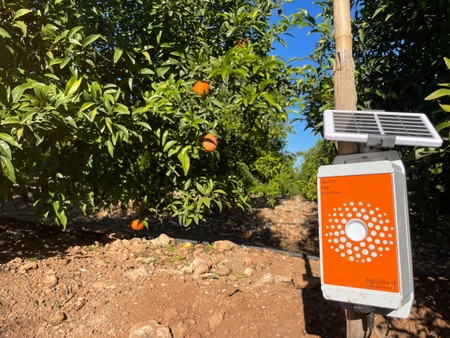CASE STUDY: AGRISOUND
With over 75% of fruit crops and as much as £375B of economic activity dependent on insect pollination, there is a tremendous and urgent requirement to take action to reverse the decline of pollinators.
Efforts are being made worldwide to address these issues. Conservation initiatives, habitat restoration, and the implementation of more pollinator-friendly practices in agriculture are some of the steps being taken to help safeguard pollinator populations.
One UK apitech company, AgriSound, is on a mission to protect pollinators by revolutionizing the way insect activity is monitored. Agrisound are protecting bees and insect biodiversity with a unique acoustic monitoring technology.

Honeybee populations have been experiencing declines in various parts of the world due to a phenomenon known as Colony Collapse Disorder (CCD). This is a complex issue influenced by factors like pesticides, habitat loss, parasites, and diseases. Wild bee populations, which include many different species, have also been declining. This is often due to similar factors affecting honeybees, such as habitat loss, pesticide exposure, and diseases.
Agrisounds approach aims to enhance understanding of insect behavior using advanced bio-acoustic algorithms. Capturing pollinators by type and number and feeding that data to an analytics application enables agronomists, big agriculture companies and farmers alike to increase yields, reduce toxic inputs and meet sustainability goals.

Agrisounds sensors are easy to deploy and immediately begin to collect data to aid decision making. Optimised for attracting pollinators – The bright orange colour along with size and shape encourage visits from a wide spectrum of local insects including bees and are be detected through the use of a specialised acoustic sensor. Data is transmitted via a cellular connection with a straight to satellite option in development. Data is then accessed via the secure Agrisound data storage platform.

Agrisound…
- Listens for insect abundance and type
- Environmental sensors provide local context
- Solar powered for continual operation
- Uses cellular data so no need for Wi-Fi
The Software: Data on the go
See pollinator levels across all devices in near real-time. Pollination activity data is presented via user interface, highlighting areas of low pollinator activity and suggesting simple interventions to increase numbers.
- Available 24/7 across any internet-enabled smart device.
- See bee activity change over time and compare between PollyTM devices.
- Use environmental data to understand changes to pollinator levels.
- Perfect for busy growers and farm staff with customisable user interface
KEY FEATURES
- 60 day battery life and option to enhance with solar panel attachment;
- 2G connectivity to ensure coverage across the globe;
- New updates will enable the detection of new species
- without the need to invest more in hardware
- Automated, customisable reports can be easily
- generated to report on biodiversity metrics.
“Pollination is crucial to maintaining healthy ecosystems by encouraging natural biodiversity, the removal of carbon from the atmosphere (from increased plant growth) and ensuring our food is jam packed full of nutrients.” Casey Woodward Ph.D, Founder & CEO, AgriSound
APITECH WORLD’S VIEW
This is an excellent solution if you are tring to gain insights into pollination patterns. Notable successes have been had with fruit growers including orchards and soft fruits. Also an excellent way to understand environmental issues and sustainability. Top sensor.
